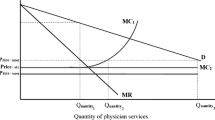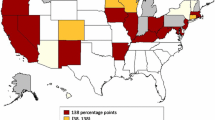Abstract
This paper uses national data on individual physicians and two control groups to provide evidence on the extent to which each of five medical malpractice reforms impacts the decision to move one's medical practice to another state. We find robust evidence that states that have implemented noneconomic damage caps experience less out-migration of physicians than states that do not have these reforms. In addition, we find some evidence that joint and several liability reforms and patient compensation funds also impact the migration decisions of physicians.
Similar content being viewed by others
Notes
For example, Michael Greco [2009], president of the American Bar Association, noted that he has “tried to emphasize the injustice of denying compensation to patients who have proven in court that they have been injured by medical malpractice” and “point out that capping malpractice awards will do nothing to make it easier for ordinary Americans to receive affordable, quality health care.”
For example, the American Medical Association [2012b] notes that it is “an outspoken advocate for liability reform as a means of protecting patients’ access to care and slowing the rising cost of health care.”
“Noneconomic” damages are those which are not easily quantified in monetary terms, such as pain and suffering, emotional distress, and others.
“Joint and several liability is a condition in which several persons share the liability for a plaintiff's injury and may be found liable individually or as a group.”
This is a national database that requires all medical malpractice claims to be reported. See http://www.npdb-hipdb.hrsa.gov/ for more information.
Veterinarians are also included in the group of health diagnosing professions but were excluded from this analysis since the animal health industry is likely quite different than the human health industry. The results were not materially influenced by this omission.
Results for dentists alone are not reported in Table 3 because these results do not provide additional information as far as our conclusions are concerned, and “Other” provides a bigger sample size.
The Current Population Survey (CPS) also has migration data. However, the CPS has a small sample size. For example, only a few hundred physicians are in any given CPS year while the total number of physicians in the ACS over the entire period was more about 33,000. It should be noted that in 2000, the ACS sample of physicians was 1,119 but grew (as did the entire ACS sample) in 2001 to nearly 3,500. In 2005, the ACS was expanded to its full-size.
Of course, the severity of malpractice climates in states may impact where new physicians locate and the retirement decision of older physicians. The annual move rates across states for physicians in the ACS during the years under study are: 13 percent for physicians under age 35; 2.2 percent for physicians in the 35–64 age category used in this paper; and 0.5 percent for physicians over age 64.
The “Health Diagnosing Occupations” are physicians, dentists, veterinarians, chiropractors, optometrists, podiatrists, and others. We exclude veterinarians as their health market is significantly different than the others. However, their inclusion does not materially alter the results.
Klick and Stratmann [2007] term this approach a “triple difference” because of the use of two control groups—physicians in states without reforms and the use of an additional within-state control group.
References
American Medical Association, (2012a). The Case for Medical Liability Reform, http://www.ama-assn.org/ama1/pub/upload/mm/-1/case-for-mlr.pdf (accessed June 18, 2009).
American Medical Association. (2012b). Practice Management, http://www.ama-assn.org/ama/pub/legislation-advocacy/current-topics-advocacy/practice-management.shtml (accessed June 20, 2009).
Avraham, Ronen . 2006. “Database of State Tort Law Reforms,” Northwestern Law and Economics Research Paper No. 06-08.
Baicker, Katherine, and Amitabh Chandra . 2005a. “The Effect of Malpractice Liability on the Delivery of Health Care.” Forum for Health Economics & Policy, 8, (Frontiers in Health Policy Research), Article 4, http://www.bepress.com/fhep/8/4.
Baicker, Katherine, and Amitabh Chandra . 2005b. “Defensive Medicine and Disappearing Doctors?” Regulation, 28 (3): 24–31.
Dranove, David, and Anne Gron . 2005. “Effects of the Malpractice Crisis on Access to and Incidence of High-Risk Procedures: Evidence from Florida.” Health Affairs, 24 (2): 802–810.
Encinosa, William E., and Fred J. Hellinger . 2005. “Have State Caps on Malpractice Awards Increased the Supply of Physicians?” Health Affairs Web Exclusive. http://content.healthaffairs.org/cgi/content/early/2005/05/31/hlthaff.w5.250.citation (accessed February, 15 2012).
Greco, Michael S. 2009. “Medical Malpractice Toolkit,” American Bar Association. http://www.abanet.org/barserv/medmal/ (accessed June 18, 2009).
Helland, Eric, and Mark Showalter . 2009. “The Impact of Liability of the Physician Labor Market.” Journal of Law & Economics, 52 (4): 635–663.
Kessler, David, and Mark McClellan . 1996. “Do Doctors Practice Defensive Medicine?” Quarterly Journal of Economics, 111 (2): 353–390.
Kessler, D., W. Sage, and D. Becker . 2005. “Impact of Malpractice Reforms on the Supply of Physician Services.” JAMA, 293 (21): 2618–2625.
Klick, Jonathan, and Thomas Stratmann . 2005. “Does Medical Malpractice Reform Help States Retain Physicians and Does it Matter?” Working paper. http://papers.ssrn.com/sol3/papers.cfm?abstract_id=453481(accessed May 1, 2009).
Klick, Jonathan, 2007. “Medical Reform and Physicians in High-Risk Specialties.” Journal of Legal Studies, 36: S121–S142.
Lynch, Michael . 2008. “Cost of Malpractice Insurance Forcing Doctors to Leave High-Risk Specialties,” Concord Monitor. http://www.concordmonitor.com/apps/pbcs.dll/article?AID=/20080313/OPINION/803130304 (accessed June 18, 2009).
Matsa, David . 2007. “Does Malpractice Liability Keep the Doctor Away? Evidence from Tort Reform Damage Caps.” Journal of Legal Studies, 36: S143–S182.
Polsky, Daniel, Steven C. Marcus, and Rachel M. Werner . 2010. “Malpractice Premiums and the Supply of Obstetricians.” Inquiry, 47 (1): 48–61.
Reyes, Jessica Wolpaw . 2010. “The Effect of Malpractice Liability on the Specialty of Obstetrics and Gynecology,” NBER Working Paper No. 15841, National Bureau of Economic Research.
Tibbles, Kevin . 2004. “High Premiums Force Many Doctors to Move,” NBC News. http://www.msnbc.msn.com/id/4798572 (accessed February 20, 2012).
Additional information
*John J. Perry is an Associate Professor of Economics at centre college and is an applied microeconomist with an active research agenda in Labor and Health Economics. He received his Ph.D. in economics from the University of Kentucky. His most recent papers investigate the labor market impacts of non-physician practitioners receiving greater practice authority and the impact of medical malpractice reform on health labor markets. Before returning fulltime to academia, he was a staff economist for the Legislative Research Commission of the Kentucky General Assembly, where he performed non-partisan research and policy analysis for policy makers and staff. He was the General Assembly's economist with duties over labor, health, and gaming issues.Christopher Clark is an Associate Professor of Economics at Georgia College and State University. He received his Ph.D. in economics from the University of Kentucky in 2005, with fields in Public Economics and Labor Economics. He has published on topics ranging from attractiveness to gambling and has done significant consulting work in public education for the Georgia Governor's Office of Student Achievement.
Rights and permissions
About this article
Cite this article
Perry, J., Clark, C. Medical Malpractice Liability and Physician Migration. Bus Econ 47, 202–213 (2012). https://doi.org/10.1057/be.2012.18
Published:
Issue Date:
DOI: https://doi.org/10.1057/be.2012.18




